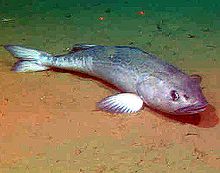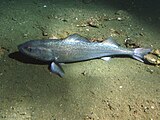This is an old revision of this page, as edited by Plantdrew (talk | contribs) at 19:39, 3 June 2014 (→In popular culture: delete unreferenced section). The present address (URL) is a permanent link to this revision, which may differ significantly from the current revision.
Revision as of 19:39, 3 June 2014 by Plantdrew (talk | contribs) (→In popular culture: delete unreferenced section)(diff) ← Previous revision | Latest revision (diff) | Newer revision → (diff)
| Sablefish | |
|---|---|

| |
| Anoplopoma fimbria | |

| |
| Scientific classification | |
| Kingdom: | Animalia |
| Phylum: | Chordata |
| Class: | Actinopterygii |
| Order: | Scorpaeniformes |
| Family: | Anoplopomatidae |
| Genus: | Anoplopoma Ayres, 1859 |
| Species: | A. fimbria |
| Binomial name | |
| Anoplopoma fimbria (Pallas, 1814) | |
The sablefish, Anoplopoma fimbria, is one of two members of the fish family Anoplopomatidae and the only species in the Anoplopoma genus. In English, common names for it include sable (USA), black cod (USA, UK, Canada), blue cod (UK), bluefish (UK), candlefish (UK), coal cod (UK), coalfish (Canada), beshow, and skil(fish) (Canada), although many of these names also refer to other, unrelated, species. In the USA, the FDA accepts only "sablefish" as the Acceptable Market Name; "black cod" is considered a vernacular (regional) name and should not be used as a Statement of Identity for this species. The sablefish is found in muddy sea beds in the North Pacific at depths of 300 to 2,700 m (1000 to 9000 ft) and is commercially important to Japan.
The white flesh of the sablefish is soft-textured and mildly flavored. It is considered a delicacy in many countries. When cooked, its flaky texture is similar to Patagonian toothfish (Chilean sea bass). The meat has a high fat content and can be prepared in many ways, including grilling, smoking, or frying, or served as sushi. Sablefish flesh is high in long-chain omega 3 fatty acids, EPA and DHA. It contains about as much as wild salmon.
Ecology
The sablefish is a species of deep sea fish common to the North Pacific ocean. Adult sablefish are opportunistic feeders, preying on fish (including Alaskan pollock, eulachon, capelin, herring, sandlance, and Pacific cod), squid, euphausiids, and jellyfish. Sablefish are long-lived, with a maximum recorded age of 94 years.
References
- Froese, Rainer; Pauly, Daniel (eds.). "Anoplopoma fimbria". FishBase. October 2005 version.
- List of common names at Fishbase
- 2010 FDA Seafood Complete List http://www.accessdata.fda.gov/scripts/SEARCH_SEAFOOD/index.cfm?other=complete
- http://www.fishwatch.gov/seafood_profiles/species/cod/species_pages/sablefish.htm#seafood-tab
- "Anoplopoma fimbria". Integrated Taxonomic Information System. Retrieved 24 January 2006.
- Yang, M-S and M. W. Nelson 2000. Food habits of the commercially important groundfishes in the Gulf of Alaska in 1990, 1993, and 1996. NOAA Technical Memorandum NMFS-AFSC-112. 174 p.
- Kimura, Daniel K., A. M. Shaw and F. R. Shaw 1998. Stock Structure and movement of tagged sablefish, Anoplopoma fimbria, in offshore northeast Pacific waters and the effects of El Nino-Southern Oscillation on migration and growth. Fish. Bull. 96:462-481.
Further reading
- Alaskan sablefish stock assessment
- Sablefish on the NOAA site
- Canadian Sablefish Association
- Sablefish NOAA FishWatch. Retrieved 7 November 2012.
Categories:
